Tent Worms: 10 Effective Ways to Get Rid of Tent Caterpillars
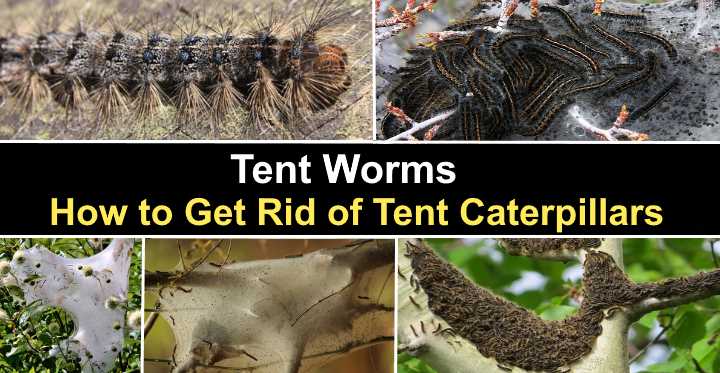
Tent worms are species of caterpillars in the genus Malacosoma. Also called tent caterpillars, they have long slender bodies up to 2” (5 cm) long with white marks on their back and hairy spines. Distributed throughout much of the United States and Canada, tent worms get their name from the large tent-like webs that they spin to protect larvae from predators and the elements.
Tent worms are more of a nuisance than an actual threat to trees, as they typically don’t cause serious harm to healthy, mature trees. However, sometimes it’s necessary to get rid of them, as large colonies can cause significant damage. In addition, the larvae can be a nuisance when they begin to wander to protected areas to pupate. They are often found by the thousands crawling over roads, streets, driveways, walkways, fences, and buildings.
Some natural ways of eradicating tent worms (tent caterpillars) include neem oil and the Bacillus thuringiensis bacterium. Introducing natural enemies, such as various types of parasitic wasps and tachinid flies, can also help reduce tent worm numbers. You can also prevent tent worms by removing the caterpillar egg nests in the fall.
This article is a complete guide to getting rid of tent worms naturally. Because tent worm control involves knowing about these caterpillars’ behavior, you’ll also learn about the Malacosoma life cycle.
What are Tent Worms?

Tent caterpillars congregate on a tree
Tent worms are the larvae of several species of moth native to North America. In the larvae stage, tent caterpillars congregate in masses on trees in spring and summer. Most species of tent worms have dark segmented bodies with white markings.
Tent caterpillar primarily feed on a variety of deciduous trees and specific shrubs. Among their preferred host trees are apple, cherry, crabapple, oak, poplar, willow, birch, and maple trees. These caterpillars tend to infest these deciduous trees, often constructing their distinctive silken tents in the crotches of branches. Additionally, certain shrubs such as wild cherry, black cherry, and shadbush can also serve as host plants for tent caterpillars.
There are 26 tent worm species, and six are found in Mexico, the U.S., and Canada. The three common tent caterpillar species are the Eastern tent caterpillar (Malacosoma americanum), Western tent caterpillar (Malacosoma californicum), and the forest tent caterpillar (Malacosoma disstria).
Tent caterpillars are active in late spring and summer. As with most species of caterpillars, tent worms have a ravenous appetite. Tent caterpillars are more of a nuisance than a threat to tree vigor. Their feeding does not typically cause serious harm to healthy, mature trees. The damage they inflict is primarily cosmetic, resulting in trees that appear ragged or unsightly.
Tent worms are similar to fall webworms. Both species of caterpillars weave tent-like web structures for protection. However, tent worm nests tend to be in the crotch of tree branches, whereas webworms are generally on branches’ ends. Additionally, tent caterpillars destroy plants in spring and summer, and webworms are active in the fall.
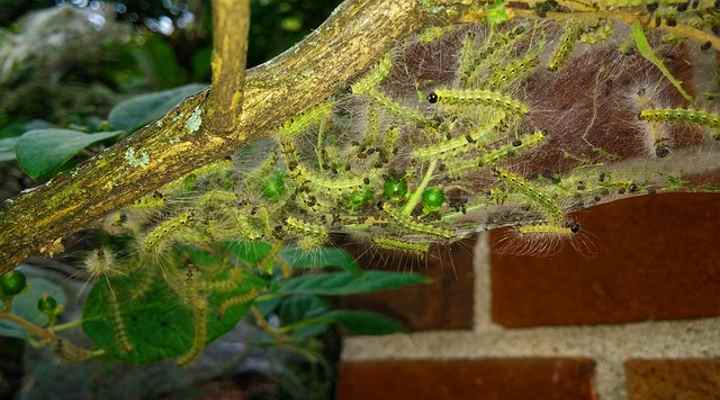
A picture of fall webworms which are similar to tent worms. They can vary in color from light yellow to dark grey
Tent Worm Identification
You can spot tent worms on trees as dark hairy caterpillars that munch through tree leaves. You can identify tent worms by their white spots on their abdominal segments. The wriggling caterpillars are also recognizable by their spiny body, giving the worm-like creatures a fuzzy appearance.
Let’s look in more detail at the individual tent caterpillar species.
Forest tent caterpillar (Malacosoma disstria)

Forest tent caterpillar
The forest tent caterpillar has a dark gray or brown body, yellow and pale-blue lines along its side, and white keyhole-shaped markings on its back. You can identify forest tent worms by the white spines, making the caterpillar look relatively hairy. This species is distributed across the United States and Canada, particularly in areas where hardwoods are found. Forest tent caterpillars can reach a length of up to 2.5 inches (6.5 cm).
The adult forest tent caterpillar moths are light yellow to tan in color, with two dark bands on their forewings. They are about 1-1/2 inches long. Host plants for this species include deciduous trees such as beech, ash, birch, maple, red oak, willow, and elm. They may also be found on hawthorn, cherry, peach, pear, and plum trees.
Despite its name, the forest tent caterpillar does not spin a true tent but instead forms a silken mat on the surface of branches where they congregate.
Eastern tent caterpillar (Malacosoma americanum)

Eastern tent caterpillar
The Eastern tent caterpillar is a striped caterpillar with a dark brown-black body with a white stripe on its back, blue spots on the side, and fine reddish spines on the abdominal segments. Eastern tent caterpillars grow 2” (5 cm) long, and you can spot them as writhing masses of caterpillars on trees. Eastern tent caterpillars look like species of gypsy moth caterpillars or fall webworms.
Eastern tent caterpillars construct their tent-like nests in the forks of branches and feed on leaves outside the tent.
The adult Eastern tent caterpillar moths are reddish-brown in color, with two white bands running diagonally across each forewing. They measure about 1-1/2 inches long. Host plants for this species include cherry, apple, and crabapple, although they can also be found on various shade trees.
It’s worth noting that while Eastern tent caterpillars are more of a nuisance than a direct threat to tree health. In addition, they also create unsightly silken nests. These nests are constructed on the surfaces of branches where the caterpillars congregate. They can be an eyesore, especially when exposed due to extensive defoliation.
Western tent caterpillar (Malacosoma californicum)
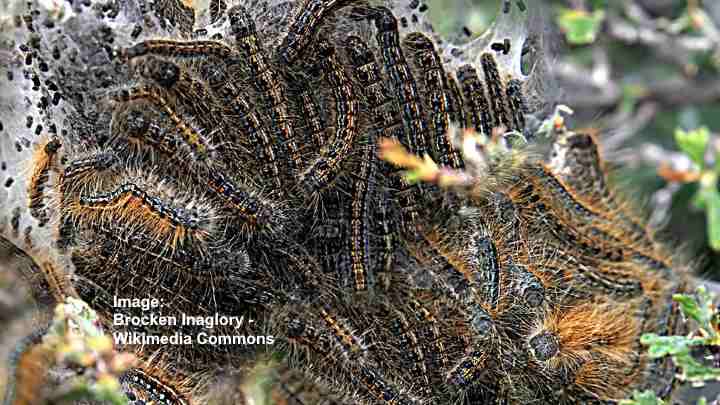
Western tent caterpillar
The Western tent caterpillar can be black, gray, or white with an orange stripe running down its body. You can identify Western tent caterpillars by the blue and white lines on the sides and orangey hairs covering the body. Western tent caterpillars grow up to 2” (5 cm) long.
The adult Western tent caterpillar moths are orange-brown, with two narrow yellow lines on their wings. They are approximately 1-1/2 inches long. Willow, poplar, cottonwood, birch, apple, plum, cherry, roses, and oak are some of the preferred host plants for Western tent caterpillars.
Are fall webworms tent caterpillars?

A close up image of fall webworm (Hyphantria cunea)
It’s easy to confuse tent caterpillars (Malacosoma species) with fall webworms (Hyphantria cunea). To identify between the two species, look for their tent-like webs and markings. Here are some ways to tell the caterpillars apart:
- Tent caterpillars spin protective web tents close to the trunk, not at the end of branches.
- Tent caterpillars tend to have white markings on the abdominal segments rather than black or reddish spots.
- Tent caterpillars are active during spring and summer, whereas webworms are active in the fall.
- Tent caterpillars are more destructive than webworms.
Tent Worm (Tent Caterpillar) Life Cycle
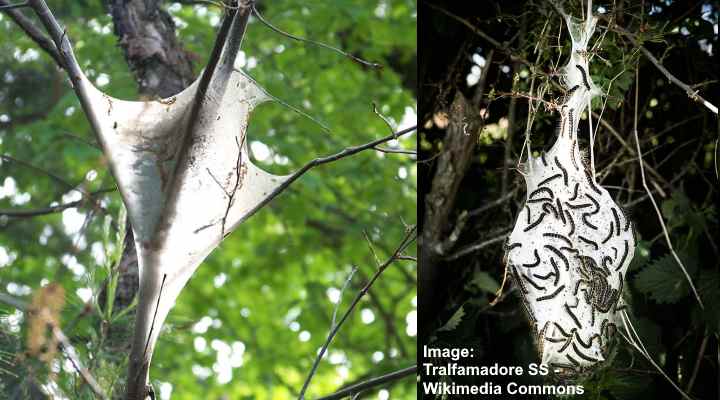
Tent caterpillar nests
The life cycle of tent caterpillars starts in a cluster of eggs that female adult moths lay on branches. The caterpillar egg cluster looks like a brown mass attached to a branch. There can be up to 400 eggs in one cluster.
The tent worm eggs hatch in early spring and soon go to work, devouring foliage on the host tree. The young larvae are gregarious feeders and chew their way through new buds, leaves, and flowers. After hatching, the caterpillar grows and goes through five instars in six weeks. By this time, the tent worms are around 2” (5 cm) long and almost hairless.
The next stage on the tent worm life cycle is the pupa stage, where the caterpillar turns into a moth. After two weeks, the adult moths emerge from the cocoons, and the females lay eggs again, where the tent worm cycle begins again.
When it comes to eradicating tent worms, it’s good to know that the pesky caterpillars only have one generation a year. If you get rid of the tent worm eggs, you will have few—if any—caterpillars the following year to deal with.
Where to Find Tent Worms
The first step of eradicating tent worms is knowing where to find the creepy crawlies. It’s vital to inspect ornamental plants, fruit trees, and shrubs in your yard. Look for thick silky tents where branches meet the main stem or tree trunk. It’s not uncommon to find many small tent worm nests on trees or bushes.
If the infestation is already large, you may notice masses of black caterpillars wriggling around the tent worm nest. You will also probably see damaged leaves where the web-spinning caterpillars have been feeding.
You can get rid of tent caterpillars in the early larval stage by removing the silky web nests. Take a stick and wind the silk webbing around it as if you were making cotton candy. Removing the caterpillar nests is just the first stage in eliminating tent worms from your yard.
Tent Worm Damage
Defoliation is the most significant damage that tent worms cause. If left unchecked, hundreds of tent worms can strip foliage from flowering trees, fruit trees, shrubs, or ornamental plants. Although tent worms rarely kill trees, the caterpillar damage makes plants look unsightly. Tent caterpillar damage also slows down plant growth.
Part of the reason tent worms are such destructive caterpillars is that they feed in groups. The crawling creatures leave their protective webs during the day to gorge on vegetation. The ravenous worms may also start feeding on nearby shrubs and plants, causing even more devastation.
How to Get Rid of Tent Worms
To get rid of tent worms, employ a multi-faceted approach. Use biological insecticides, like Bacillus thuringiensis (Bt), during the early stages of infestation, targeting young and vulnerable tent worms specifically. Additionally, manually remove overwintering tent worm egg masses, and eliminate the protective tents before the larvae begin to feed.
Encourage natural enemies of tent worms, such as birds and parasitic wasps, by fostering a diverse ecosystem.
Regularly prune and remove branches hosting tent worm nests to prevent the spread of the infestation.
If necessary, resort to chemical control as a final option, selecting insecticides labeled for tent worms and applying them in accordance with provided guidelines. Be mindful that chemical insecticides can potentially affect various beneficial insects, including honeybees, so their use should be carefully considered.
Let’s look in more detail at ways of getting rid of tent caterpillars from trees, shrubs, and ornamental plants.
Remove Tent Worm Webs by Hand
The first step in your battle against tent caterpillars is to remove the worms by hand. The best time to catch these leaf-destroying pests is in the early morning or evening. Typically, this is when you’ll find the gorging insects in their web tents.
To kill the tent worms without chemicals, take a large stick, and wrap the silky web structure around the end. Then put the web along with the masses of caterpillars into a bucket of hot, soapy water. The hot water and dish soap will suffocate the fat tent worms.
Suppose you have larger trees, or you see many small nests on trees. In that case, you may have to use natural insecticides to eradicate the squirming insects.
Organic Neem Oil Spray to Kill Tent Worms
Use a natural neem oil spray to kill garden pests such as tent caterpillars. Make a neem oil spray by combining 2 teaspoons neem oil, 1 teaspoon liquid Castile soap, and 1 quart (1 l) of warm water. Mix the ingredients in a spray bottle and liberally spray areas where you see tent caterpillars to get rid of them.
Use the neem oil spray once a week for best results in getting rid of tent worm infestations on trees, shrubs, and ornamental plants.
Neem oil works on tent worms because it contains azadirachtin—a naturally-occurring insecticidal substance. The natural pesticide interferes with larvae growth and development and prevents them from feeding. By spraying plants with neem oil, you will protect them from other nasties but not harm beneficial insects or bees.
According to research on neem oil, a solution with neem oil is effective against various larvae types. Studies have shown that applying neem oil prevents larvae from developing, poisons larvae and adults, interferes with metamorphosis, and has a repellent action.
Spinosad Spray to Eradicate Tent Worms Naturally
Spinosad is an organic pesticide spray that is effective at getting rid of tent caterpillars. The easiest way to use Spinosad spray for killing tent caterpillars is to buy a commercial product. Most Spinosad sprays are suitable for organic gardening techniques.
Spinosad is a naturally-occurring soil bacterium that is harmful to pests. As well as using Spinosad sprays on tent worms, you can use it to get rid of leaf miners, spider mites, thrips, and other garden pests. Spinosad works by affecting the nervous system of harmful insects and their larvae.
Scientific evidence suggests that Spinosad is effective on Malacosoma species. Studies found that the substance has a toxic effect on certain Malacosoma larvae, especially in their fourth and fifth instars.
Spray Tent Worms and Eggs with Bacillus Thuringiensis (Bt) to Kill Them
Bacillus thuringiensis (Bt) is a natural contact biological insecticide that kills tent caterpillars. Bt sprays are useful for killing tent worms in their early stages. It would be best if you sprayed the Bacillus thuringiensis on caterpillar nests in the early morning or late evening. The larvae ingest the Bt bacterium, stop feeding, and starve to death.
Getting the right Bacillus thuringiensis strain is crucial for ensuring that Bacillus thuringiensis is effective against Western tent caterpillars, Eastern tent worms, and forest tent caterpillars. Some research suggests that Bacillus thuringiensis kurstaki is most effective on tent caterpillars.
To use Bacillus thuringiensis on tent caterpillars, you should follow the manufacturer’s instructions.
Introduce Natural Enemies to Kill Tent Worm Larvae
Introduce natural enemies to your garden to get rid of tent caterpillars naturally. For example, parasitic wasps, tachinid flies, spiders, and birds feed on tent worm larvae, reducing their numbers. Because tent caterpillars only have one generation a year, beneficial insects and animals can be extremely useful for eliminating tent caterpillars.
Small parasitic insects and flies lay eggs in or on larvae and kill the caterpillars before they mature.
Birds eat tent worm larvae. So, if you make your backyard bird-friendly, you will help eliminate a large number of tent caterpillars. Birds are most effective at killing tent caterpillars when the insects are in their immature state—the first or second instar.
How to Prevent Tent Worms
Because tent caterpillars only have one generation in a year, it’s crucial to prevent their eggs from hatching. So, removing the eggs is one of the best ways of avoiding tent caterpillars defoliating your trees, ornamental plants, and flowering shrubs.
Let’s look in detail at a few ways of preventing tent caterpillars.
Remove Eggs to Prevent Tent Worms
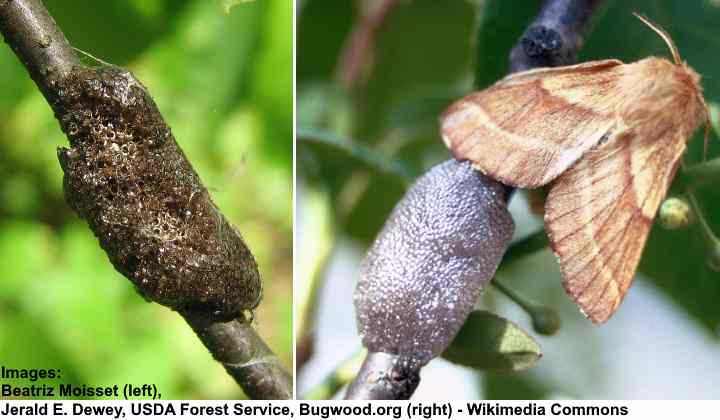
Eggs of Eastern tent caterpillar moth (left) and Western tent caterpillar adult moth (right)
The first step in preventing tent caterpillars is to remove the egg masses. Eradicate the egg clusters by carefully scraping them off the branch. Place in a sealable bag and dispose of the caterpillar eggs. Clusters of caterpillar eggs look like a shiny, dark brown mass encasing twigs or branches.
Destroy Tent Worm Cocoons to Prevent Laying Eggs
Another tent caterpillar prevention method is to eradicate cocoons in the summer. Gather the cocoons, seal them in a bag, and dispose of them in the trash.
Look for yellow or white cocoons hanging from trees that tent worms typically infest. You could also find the Malacosoma cocoons on fences, tree trunks, and debris on sheltered areas.
Prune Trees to Control Tent Worms
You can also prevent tent caterpillars from overtaking your garden and destroying plants by pruning affected branches. In spring, prune branches from apple, cherry, plum, or broadleaf trees where you see the distinctive caterpillar web tents. Get rid of the pruned foliage in the trash to prevent caterpillars from hatching on trees or bushes.
When you remove tent caterpillars, it’s a good idea to have a bucket of soapy water with you. If you find any tent worms crawling around the ground or on trees, you can kill them by dropping them in the soapy solution.
Top tip when removing tent caterpillars: Avoid squashing or smashing tent worms. They tend to leave unsightly stains that are difficult to remove.
Improve Tree Health to Prevent Tent Caterpillar Damage
Broadleaf trees, fruit trees, and ornamental shrubs usually survive a severe tent caterpillar attack. After serious defoliation, promote good tree health by providing plenty of compost and organic matter.
Related articles:
